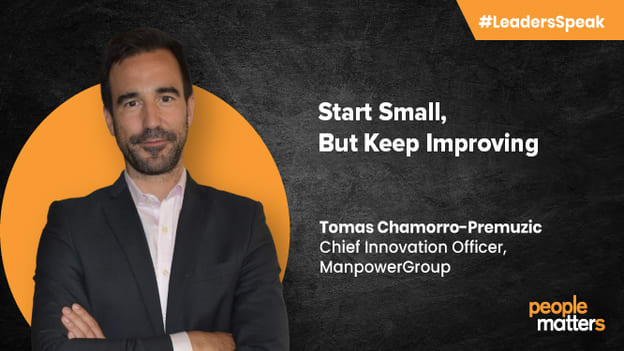Failing fast is the best way to succeed in the long term: Tomas Chamorro-Premuzic

Tomas Chamorro-Premuzic is Chief Innovation Officer at ManpowerGroup and Professor of Business Psychology at Columbia University and University College London. He previously held academic positions at New York University and the London School of Economics. He is also co-founder of Deeper Signals and Metaprofiling.
Tomas throws light on some of the key questions around innovation, including how the past two years of the pandemic changed how organisations view it.
What has changed about the concept of innovation over the past two years in terms of how organisations view it?
I see three major trends globally. First, the wider deployment of AI across all industries. Second, the bigger focus on ethical AI across all industries, especially when the impact is on human behaviour, whether in human capital, consumer, and health. Third, the realisation that digital transformation is essentially about talent (people and culture), rather than tech or data. For organisations to become data-centric, they need to invest more in upskilling and reskilling their workforce.
How should business leaders decide what innovations to prioritise, amid this ongoing uncertainty?
The key is to clearly define what innovation means to you in your organisation. This includes understanding the process by which creative ideas translate into practical drivers of positive change and progress. There is so much variability – in terms of models, governance, and types of innovation which include incremental, operational, disruptive, and breakthrough. Being problem-led rather than solution-driven is key. Typically, organisations don’t suffer from a shortage of creative ideas, but what they lack lies in the process or method, including the culture, to translate them into effective and impactful innovation. Finally, we need to accept that uncertainty will continue to exist and this is especially true with regard to innovation. If you know it’s going to work, then it’s not innovation.
MORE FOR YOU...
- Google's Frederik Pferdt on innovation mindset
- Are we building responsible tech?
- We need to evolve our work culture: VMware's Betsy Sutter
- What's swelling the demand for freelancers globally?
Can you share two tips on how organisations can innovate their way into the post-pandemic era?
Start with the most important problem – and start small, but keep improving. Failing fast is the best way to succeed in the long term, even if success comes slowly. The aim is not perfection, but finding better ways of being wrong.
What are the characteristics and lenses of successful innovation?
The main criteria are economic, social (including ESG), and human (enabling talent to thrive and grow). Then there are ‘levels’ – how you improve things for your clients, employees, and business. Even small tweaks to how things are done can lead to important changes in the long run.
Can you share examples of two successful innovations?
One example is Netflix disrupting itself: starting with an incrementally better alternative to Blockbuster, moving to a disruptive streaming on-demand subscription model, moving to become a quality content provider. The key here is not about following your clients’ needs but about always trying to disrupt yourself, which eventually lets you create something that not even your clients know they want.
Another is Amazon’s constant incremental innovation (of traditional companies). Toyota’s Kaizen is equivalent. Be totally client-centric, start quickly and small, but aim big and move fast. Constantly improve and diversify into as many verticals as possible. What started as an online book store became not just the “everything store”, but the defining innovator of our time in almost every area they play.
Why do the majority of innovation initiatives fail across organisations and industry verticals?
Underestimating the practicalities of change management, execution, process-discipline, and lack of clarity in strategy (as well as culture which, as we know, eats strategy for breakfast: innovation strategy is probably its favourite dish).
How can organisations determine if they have the required capabilities to innovate successfully?
They don’t. They only find out after they reflect on their successes and failures.
What have you learned about innovation from the two years of disruption triggered by the pandemic?
The more innovative companies were before the pandemic, the less they suffered from it. The more companies suffered from the pandemic, the more they realised they should have innovated.
----
Join People Matters Futurist Forum and learn from experts how to lead larger business transformations.






